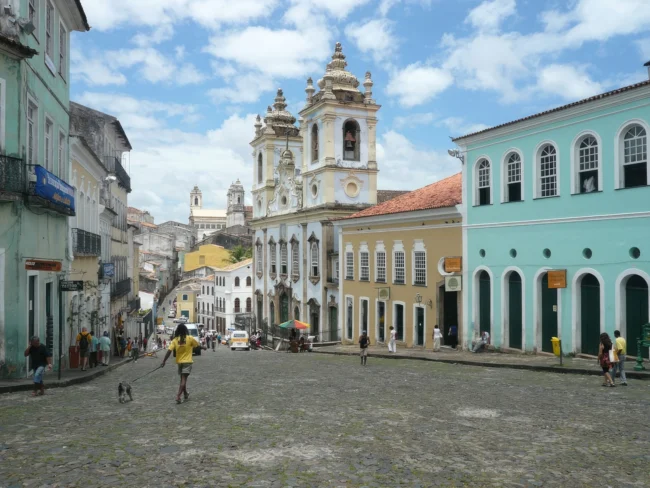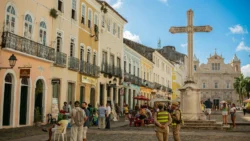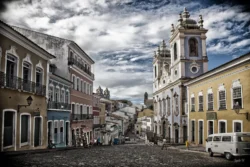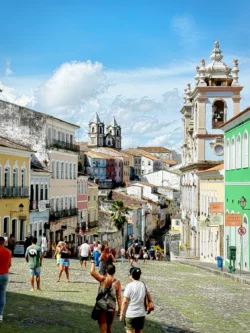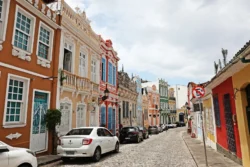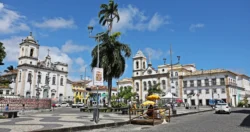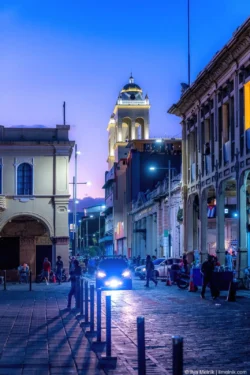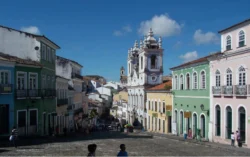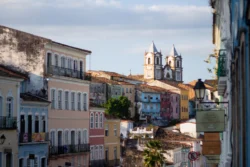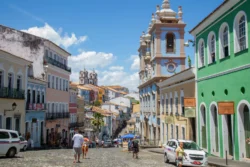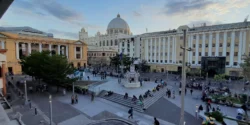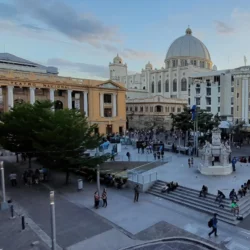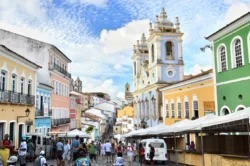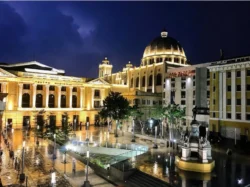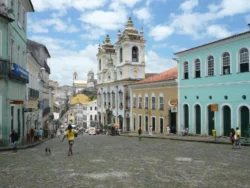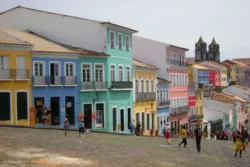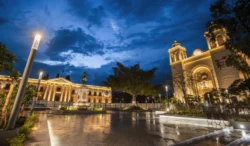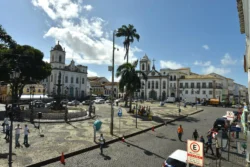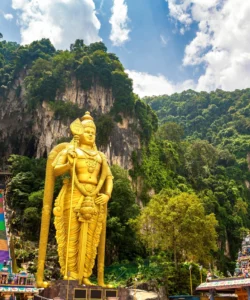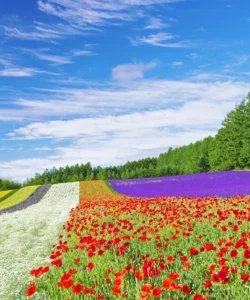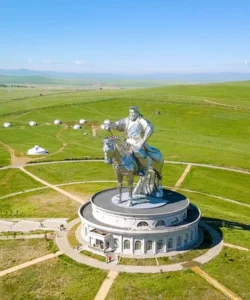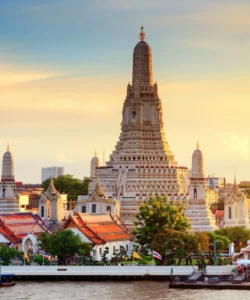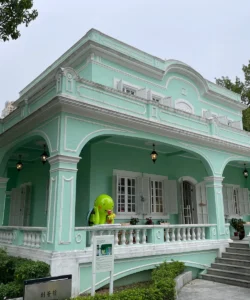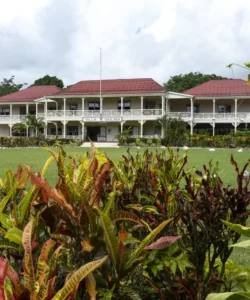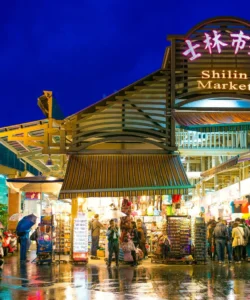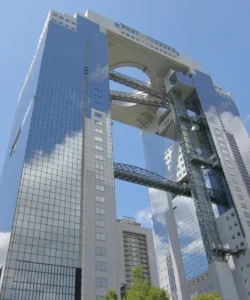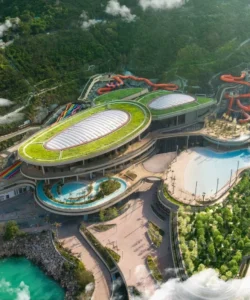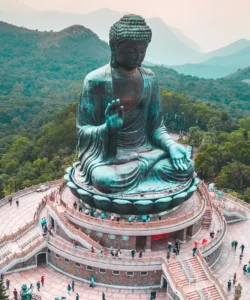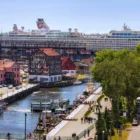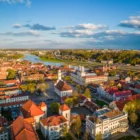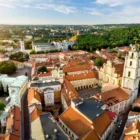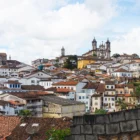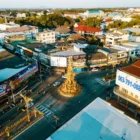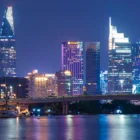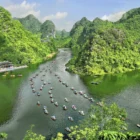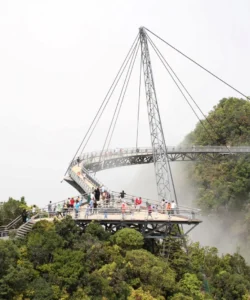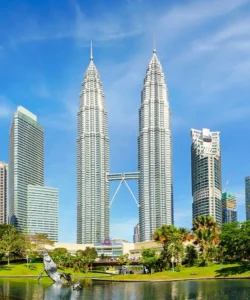The Historic Center of Salvador, famously known as Pelourinho, is the heart and soul of Salvador da Bahia, Brazil’s first capital. Perched on a steep hill overlooking the Baía de Todos os Santos (All Saints’ Bay), this vibrant district is a living museum of colonial Portuguese architecture, cobblestone streets, and a powerful testament to Brazil’s rich Afro-Brazilian heritage. A UNESCO World Heritage site, Pelourinho is celebrated for its colorful colonial mansions, ornate churches, lively music and dance, and its profound cultural significance as a cradle of Afro-Brazilian identity and a crossroads of history.
Name: Historic Center of Salvador (Centro Histórico de Salvador). Commonly called Pelourinho (meaning “pillory” or “whipping post,” referring to the public square where slaves were punished).
Address: Salvador, Bahia, Brazil. The main square is Praça Municipal.
How to get there:
Reaching the Historic Center of Salvador, involves a very long international journey to South America, followed by domestic travel within Brazil, and then local transfers in Salvador:
- From Salvador Airport (SSA) to Pelourinho:
- Taxi/Uber/99 (Ride-hailing): The most convenient option. Takes approximately 30-50 minutes, depending on traffic. Agree on a fixed fare for taxis or use the app.
- Airport Bus: Several bus lines connect the airport to various parts of Salvador, including routes that pass close to Pelourinho (you may need a short taxi/Uber for the last leg).
- Within Salvador to Pelourinho:
- Elevador Lacerda: An iconic art deco public elevator that connects the Cidade Alta (Upper City, where Pelourinho is) with the Cidade Baixa (Lower City, where the Mercado Modelo and ferry terminal are). This is a unique and quick way to access the Pelourinho from the lower part of the city.
- Buses: Numerous city bus routes serve the Pelourinho area.
- Taxi/Uber/99: Readily available.
- On Foot: If staying in a hotel within or very close to Pelourinho, exploration is best done on foot.
Best Time to Visit:
Salvador has a tropical climate, generally warm and humid year-round.
- Dryer Season (June to September): Less rain, pleasant temperatures (average 25-30°C / 77-86°F), making it ideal for exploring the cobblestone streets and enjoying outdoor cultural performances.
- Rainy Season (April to May): Can experience heavy downpours, but these are often short bursts. The city is lush and vibrant.
- Summer (December to March): Hot and humid, but also the high season with more festivals and events, including pre-Carnival celebrations.
Landscape and Architecture:
Pelourinho’s “architecture” is its preserved colonial urban fabric, characterized by vibrant colors, intricate details, and a hilly topography:
- Colorful Colonial Mansions: The most striking feature. The district is renowned for its narrow, multi-story colonial buildings, often painted in a vibrant palette of pastel yellows, blues, greens, pinks, and reds. These buildings typically have wrought-iron balconies and intricate wooden doors, reflecting Portuguese colonial Baroque and Rococo styles.
- Cobblestone Streets and Steep Alleys: The entire district is a labyrinth of winding, often steep, cobblestone streets and alleys. This pedestrian-friendly (though often challenging to walk) environment enhances the historical ambiance.
- Baroque Churches: Pelourinho is home to some of Brazil’s most magnificent and ornate Baroque churches, built with immense wealth from gold and sugar during the colonial period:
- Church of São Francisco (Igreja e Convento de São Francisco): A UNESCO masterpiece, its interior is overwhelmingly gilded with tonnes of gold leaf, creating a dazzling effect. It also features intricate Portuguese azulejo (blue-and-white tiles) work.
- Cathedral Basilica of Salvador: A grand Jesuit church with a rich history and impressive interior.
- Church of Our Lady of the Rosary of the Black People (Igreja de Nossa Senhora do Rosário dos Pretos): Built by and for the enslaved African population, its simpler facade belies a beautiful, moving interior and a profound cultural significance. It still hosts services with Afro-Brazilian rhythms.
- Public Squares: Several charming public squares, often with fountains, serve as gathering points for locals and stages for performances. The Largo do Pelourinho (the actual Pillory Square) is particularly famous for its lively atmosphere.
- Elevador Lacerda: While outside the immediate Pelourinho district, this iconic Art Deco public elevator (built in 1873, modernized over time) is a crucial architectural link, connecting the upper and lower cities and offering panoramic views of the bay.
- Integration with the Landscape: The district is built on a steep hill, offering dramatic views down to All Saints’ Bay (Baía de Todos os Santos) and the lower city. The colonial planning adapted to this challenging topography.
- Candomblé Terreiros: While not public “architecture,” the presence of numerous private terreiros (worship houses) of Candomblé (an Afro-Brazilian religion) contributes to the unseen but powerful cultural landscape.
What makes it famous:
The Historic Center of Salvador (Pelourinho) is famous for:
- UNESCO World Heritage Site: Inscribed in 1985, recognized as an outstanding example of a Renaissance city adapted to a colonial site, and for its role in the development of Afro-Brazilian culture.
- Cradle of Afro-Brazilian Culture: It is the undisputed heart of Afro-Brazilian culture, where the influences of African traditions (brought by enslaved people) merged with Portuguese colonial heritage. This is evident in its music (samba, axé), dance (capoeira), religion (Candomblé), and cuisine.
- Vibrant and Colorful Colonial Architecture: Its remarkably preserved and vibrantly painted colonial mansions and Baroque churches create a stunning and unique urban aesthetic.
- Lively Music and Dance: Pelourinho pulsates with music, especially drumming. It’s the home of the Olodum drumming group, famous for their street performances and collaborations with artists like Paul Simon and Michael Jackson. You can often witness spontaneous performances.
- Religious Syncretism: The coexistence and blending of Catholicism (expressed in its Baroque churches) with African-derived religions (Candomblé) is a profound and visible aspect of its cultural identity.
- Historical Significance (First Capital, Slave Trade): As Brazil’s first capital (1549-1763), it was a major port and center for the transatlantic slave trade. The Pelourinho square itself was a place of public punishment for enslaved people, giving the district a complex and often painful history that is now acknowledged and interpreted.
- Gastronomic Hub: It offers a rich culinary scene with authentic Bahian cuisine, particularly dishes influenced by African flavors.
- Festivals and Celebrations: The district is alive with vibrant festivals throughout the year, especially leading up to Carnival.
Differences from some other wonders:
The Historic Center of Salvador (Pelourinho) distinguishes itself from other colonial old towns and cultural centers in several key ways:
- Unrivaled Afro-Brazilian Cultural Resonance: While other former slave ports exist, Pelourinho’s unmatched and deeply ingrained Afro-Brazilian cultural identity (music, dance, religion, cuisine) is its most significant differentiator. It’s not just a historical district, but a living, breathing epicenter of a unique diaspora culture.
- Baroque Opulence of Churches: The sheer extravagance and gold-gilded interiors of its Baroque churches (like São Francisco) are exceptional and rival the most ornate churches in Europe, showcasing the immense wealth generated during the colonial era.
- Living, Contested History: Unlike some pristine, static historical districts, Pelourinho has a complex and often raw history related to the transatlantic slave trade and racial inequality, which is actively acknowledged, discussed, and reinterpreted through its cultural expressions today. This ongoing engagement with its painful past makes it a unique and powerful site of memory.
- Dynamic Music and Dance Scene: The pervasive and spontaneous presence of Afro-Brazilian music and dance (especially drumming and capoeira) on its streets is a daily, interactive, and vital part of the atmosphere, setting it apart from more quietly preserved historical areas.
- Hilly Topography with Urban Lift: Its construction on a steep hill with the iconic Elevador Lacerda connecting it to the lower city creates a unique urban landscape and a specific spatial experience that is distinct from flatter colonial towns.
- Vibrant Color Palette: The consistent and bold use of vibrant colors on its colonial buildings contributes to a unique visual aesthetic that is distinct from the more subdued or uniform color schemes of some other colonial districts.
In essence, the Historic Center of Salvador (Pelourinho) is a dynamic and deeply soulful wonder, a kaleidoscope of color, music, and history that serves as a powerful testament to Brazil’s colonial past and the enduring, vibrant spirit of its Afro-Brazilian heritage.
